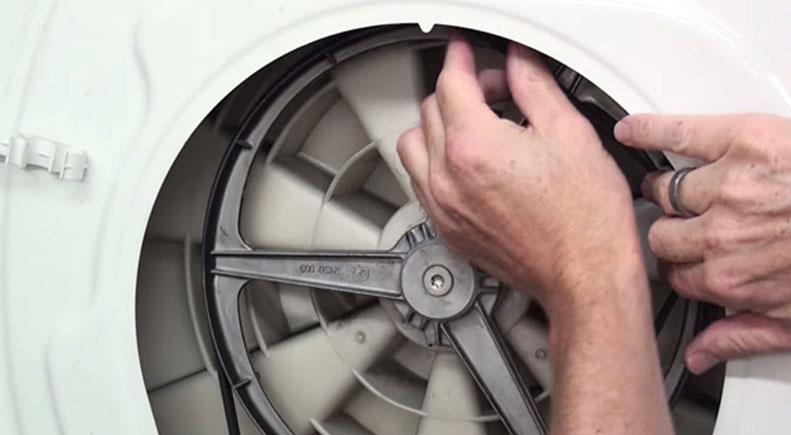
German Bosch washing machines are quite reliable, although some minor faults still occur. From time to time, machine owners are faced with the problem of the drive belt stretching and breaking. The breakdown is not considered complicated; you can fix the machine yourself without calling a technician. Let's talk about how to tighten the drive belt of a Bosch washing machine motor and what symptoms will indicate that the rubber band has fallen.
It is difficult to immediately understand that the belt has fallen off - it is located behind the rear panel of the machine body. To check your guess, you will have to unscrew the bolts and remove the wall. However, the washing machine itself can also hint at problems with the drive. How to determine that the reason the equipment stops working lies precisely in a broken rubber band?
Having detected that the drive belt has fly away, the machine will immediately inform the user about the malfunction. Machines with a display will display an error code on the display. All that remains is to look at the instructions and decipher the designation. Washing machines that are not equipped with a screen will indicate the problem by flashing indicators on the control panel.
In some cases, the “brain” of the machine does not notice the broken belt. Then the user will have to guess the cause of the machine breakdown based on indirect symptoms. You need to think about problems with the drive system if:
If one of the “symptoms” is detected, you should urgently check the drive system of the Bosch washing machine. Operating a machine with a broken drive belt is dangerous, as this will lead to overheating and engine failure. To check if the rubber is in place, you will need a screwdriver. Let us describe the basic algorithm of actions when conducting diagnostics.
If the belt has become loose and fallen off the pulley, it is not necessary to seek the help of a professional. You can put the elastic band back in place with your own hands. Tensioning the drive belt will require patience and concentration, but if you follow the instructions, you will be able to get the job done.
If the rubber band breaks the first time, you don’t have to buy a new one, but simply put it back in place. In case of regular rallies, the drive belt will have to be changed. To remove an element from the housing and assess its condition, you should:
The location of the drive belt is the same on all Bosch commutator machines. It is located directly behind the rear panel, between the drum pulley and the electric motor. If it is not visible, it means that the element has fallen off and lies under the washer.
To determine the condition of the belt, you need to find the factory markings on it. The first 4 digits of the inscription indicate the initial diameter of the elastic band in millimeter. Then you need to measure the circumference with your own hands and compare the values.
You can purchase a replacement belt in specialized stores. You should tell the seller the brand and model of the washing machine. When a similar rubber band is purchased, you can proceed to repairs. To return the part to its place, you must:
It is important to strictly follow the sequence of actions, starting from the bottom and moving to the upper “drum” pulley. If you cannot install the drive belt alone, try calling an assistant. It's easier to cope with the task together. Some Bosch models have a very tight elastic band; you will have to be patient and put in a lot of effort to tighten it.
After the element is put in place, you need to check whether it fits well. It is necessary to rotate the drum pulley - if the “wheel” is tight, it means the drive belt is tensioned correctly. Next, you can assemble the body of the washing machine:
Then the machine moves and connects to house communications and the power grid. Be sure to run a test cycle to check the machine. If the washing proceeds as normal, the work can be considered completed.
If the belt falls off regularly, even after installing a new one, you should think about it. There is probably some problem with the washing machine. Diagnostics of a Bosch automatic washing machine is necessary if the drive rubber flies off more than twice in 6 months. A permanent “failure” of an element can occur for the following reasons:
Also, the belt periodically flies off if it is not suitable for your washing machine, that is, its characteristics differ from the factory element. Therefore, when buying a new rubber band, it is important to select an analogue that matches the specific Bosch model.
Thus, if the belt becomes loose and falls out of place, there is no need to panic and call the service center (the exception is when the washing machine is still under warranty). Putting the elastic band back in place is within the power of a housewife, the main thing is to strictly follow the instructions for action and be patient.
If after a short period of time the belt drive is broken again, you will have to undertake in-depth diagnostics of the Bosch washing machine. Perhaps the problem can be solved by tightening the drum pulley or the motor fasteners. In some cases, more serious repairs will be required - replacing the bearings or wheel of the drum.
Copyright © 2020 Coimbatore Service.